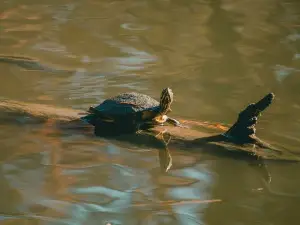
Algae can grow on a number of surfaces, and as odd as it looks, it can also grow on your pet turtle’s head.
You as a turtle raiser would understandably want to know why this is happening and if this will negatively affect your pet’s health.
This article looks into why algae is growing on your turtle’s head.
Table of Contents
Algae growing on turtle head:
Algae growing on your turtle is actually quite common and happens to a variety of turtles, but this happening may still confuse you as a turtle raiser.
This is what you need to know about algae growing on your turtles head:
Algae on your turtle’s head:
Algae can grow almost anywhere, all it needs to grow is sunlight to survive. Algae will attach to almost anything and will attach anywhere as long as it can get a lot of light.
The algae can grow in saltwater or freshwater tanks and will grow in tanks that have high levels of nitrates and phosphate.
The foods that you give your turtles, and the waste produced by the turtles, can cause high levels of nitrates and phosphates in your pet’s tank.
While it is quite common for algae to attach itself to your pet’s tank, or even to your pet’s shell, algae can also attach itself to your pet’s head.
What is worrisome is that the algae on your pet’s head can prevent UV rays from penetrating the animal’s skin.
If your pet isn’t getting enough exposure to UV rays then the animal may not be able to process enough calcium for shell growth.
If the algae moves from your pet’s head to your pet’s shell this can cause shell rot or the shell may weaken and break.
An injury may develop at the head and an infection can develop. This infection may spread and get into your pet’s bloodstream and this can kill your pet.
What to do:
You can remove the algae at home very easily but visiting your vet for more advice on the matter is still recommended.
Removal can be as easy as scrubbing your pet’s head using a soft brush or your finger.
Using a homemade algae remover is also recommended. You can make a homemade remover by mixing one part water and one part vinegar.
Scrub very gently when attempting to remove as the scrubbing motion will really bother your little pet.
You can also choose to use a commercial algae remover on your pet.
When using the commercial or homemade algae remover be sure to keep your pet from ingesting the product.
Make sure that you remove all the algae from your pet’s head. Algae will quickly grow back even if there are only small amounts of algae left on your pet’s head.
You can keep algae from growing on your pet turtle’s head, and on your pet turtle’s shell and tank, by maintaining your pet’s tank water and making sure that it is kept clean.
Using a filter, or an aerator, will also help as this will keep the tank water moving making it harder for the algae to grow in your pet’s tank or on your pet’s body.
Because scrubbing your pet’s head will be quite stressful for your pet, and will likely be stressful for you too, prevention is better than cure so maintaining a good clean tank is best.
If you enjoyed this article then you may also be interested in other turtle/tortoise related articles. Here are some articles that you may be interested in: Tortoise Bleeding Leg, Baby Tortoise Leg Problems, Tortoise Cut On Leg, Tortoise Having Trouble Walking At Night, Turtle Bulging Out Of Shell, Red Spots On Turtle Belly, Adding Salt To A Turtle Tank, Wheat Germ Pellets For Turtles, How To Fix Retained Scutes

